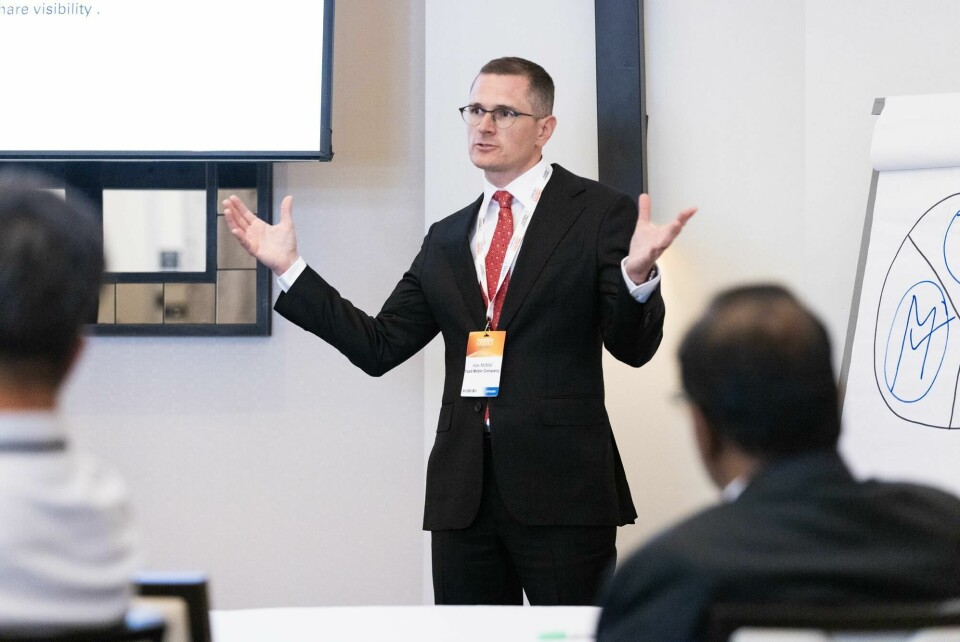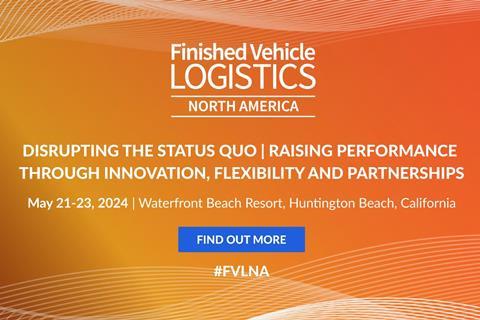Ford is increasing telematic data sharing in vehicle logistics
In one of the four Ideas Labs held at this year’s Finished Vehicle Logistics North America conference in California, Ford’s Alex McMall joined FreightVerify’s Nathan Lawson to discuss the benefits of telematics for transparent vehicle logistics

At Finished Vehicle Logistics North America 2024, Ford’s team lead on vehicle business solutions, Alex McMall was joined by Nathan Lawson, vice-president of delivery and customer success at vehicle tracking and supply chain visibility provider FreightVerify.
Ford has been working with FreightVerify for five years and using telematics to track vehicle milestones – ie capturing location information from railcars or car carrier trucks – is at the core of the service. Gaining a more consistent measure of these milestones is a priority for Ford given the variance in telematics reporting by finished vehicle logistics providers.
“We’re at a very important inflection point in the industry,” said McMall. “I think when it comes to visibility, telematics is really the thing that has been the biggest differentiator.”
Communicating vehicle milestones and providing visibility at handover points through the vehicle delivery chain is at an all-time high and carmakers have different ways of aggregating the information, but according to McMall, telematics is really what is driving ETA calculations and final mile visibility.
“What we all have to continue to march towards [is] the Amazon effect,” said McMall. “We all feel we need to get to the next level and today what we’re really hoping to accomplish is an interactive dialogue on telematics, which is still that secondary piece for our puzzle.”
Transparent value
Telematics has the potential to benefit both the shipper and the carrier, according to McMall. The technology has a value proposition for the entire finished vehicle logistics sector and that value is unlocked by complete end-to-end transparency.
”Real-time vehicle calculation is where it’s at – everybody wants to know where the vehicle is in real time, not from a report sent earlier in the day from the railroad,” said Nathan Lawson. “Along with that, when is the vehicle going to be at its final destination? It’s good to know what the segment ETA is for the benefit of the dealer and customer.”
Ford is working closely with FreightVerify to provide that visibility and the technology provider’s VinView tool provides vehicle status information to the dealerships.
“A lot of our network partners have the ability to log into FreightVerify and check on their telematics compliance, for example, or their milestone compliance. But in terms of information sharing, that platform will be for our network partners as well,” said McMall.
Full alignment on delivery expectations for all partners helps cut transit and dwell time, improves asset utilisation and lowers costs, according to Lawson.
“The reality is that visibility allows for better planning across the supply chain [and] it allows you to address some of the dwell issues,” said McMall. “Haulaway carriers want to move get VINs moved faster. If you know where the points of contention are in your supply chain, you can address them.”
Giving the dealer better visibility also enables them to take action, including picking up the vehicles themselves, which FreightVerify’s platform supports.
“It’s enabled the dealer to really take things into their own hands and go grab the vehicles, which is really key,” said Lawson. “It’s been a huge customer satisfaction advantage, and also a win for the OEMs that have deployed it.”
However, it is also about striking a balance on the amount of information shared with the dealer, something manufacturers want to limit to avoid harassment if something delays a vehicle in transit.
“It is a question of how we strike that balance where everyone gets to see what they need to see, but not everything they want,” said Lawson.

Network planning
A seamless electronic workflow better supports partner network planning. Lawson used the example of rail providers looking for better visibility on vehicle deliveries to the ports to better plan and fill available capacity rather than risk sending railcars for vehicles that have been delayed or have already left.
McMall said that eliminating black holes in the delivery process was a priority and a lot had changed in terms of sharing information from the OEM side since the chip crisis and there has been increased interest from marketing and sales, and fleet teams, in sharing more information. He said the next frontier was in providing information on in-transit repairs to the dealers. Ford works with Fenkell Automotive Services and its own Amro subsidiary, both of which provide claims and damage information, and which provide in-transit visibility. That is something Ford is working on connecting through the FreightVerify platform to provide visibility to dealers but also to clear up the points in the delivery chain that remain invisible to Ford itself.
Black holes in the outbound delivery process are also a concern for logistics providers and eliminating them is something McMall said he was passionate about. He acknowledged that visibility is a generic and broad term and its definition depends on who is the “consumer of the visibility”.
“The FreightVerify platform is helping us bridge the gap and provide that visibility to whoever needs it, whether it’s the dealer, an internal partner, a different brand, or a carrier or network partner as well,” he said.
The importance of telematics in enhancing visibility and efficiency in the outbound supply chain is clear. Together Ford and FreightVerify are building out an ecosystem where service providers and dealers get a forecast of units that are being produced, how long those vehicles have been on the ground and where they are, which supports planning respective to the partner involved based on shared metrics so that everybody is on the same page measuring with the same numbers.






